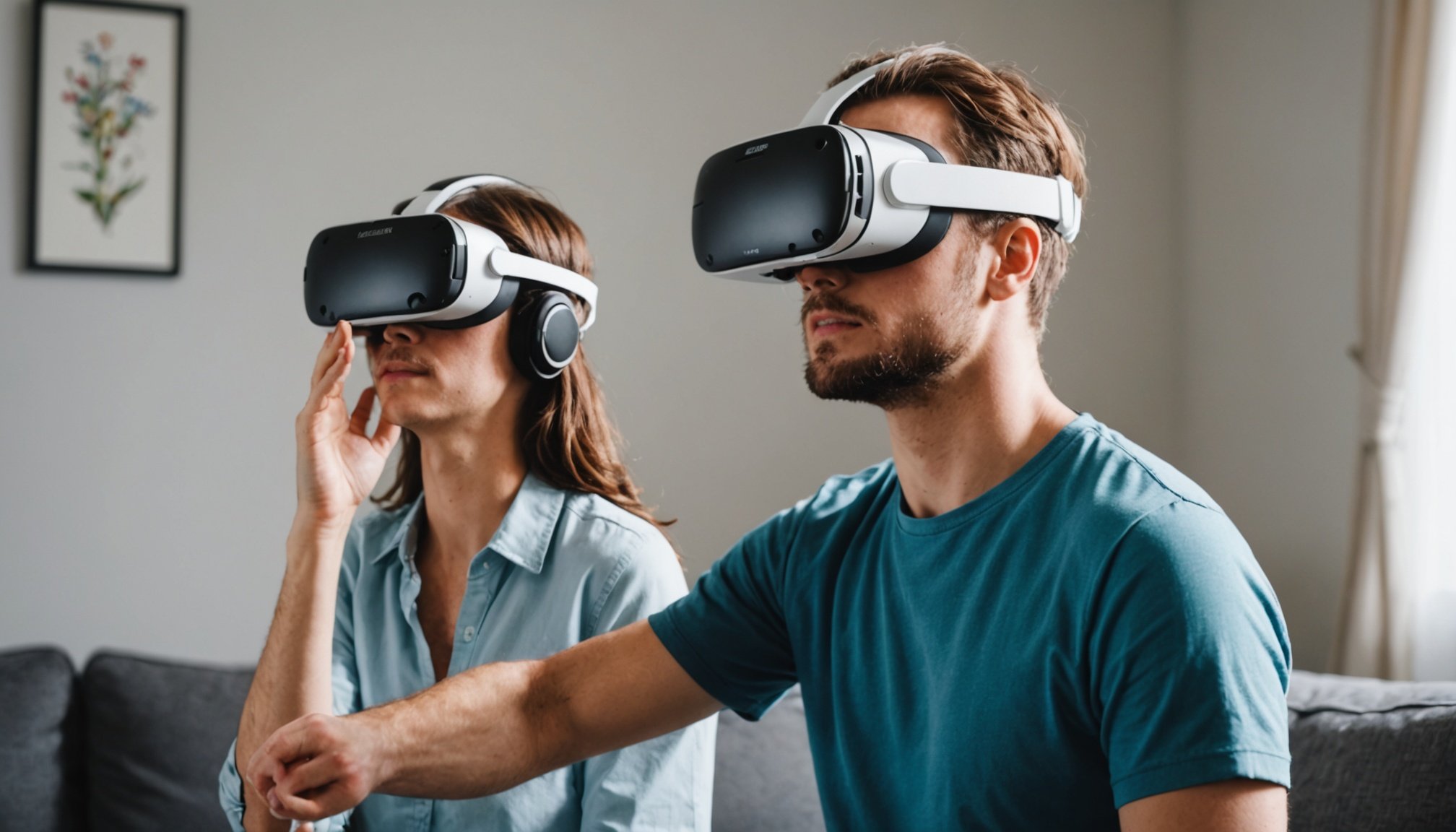Overview of Virtual Reality Technologies in Cognitive Rehabilitation
Virtual Reality (VR) technologies have emerged as transformative tools in the field of Cognitive Rehabilitation Technologies. By definition, VR refers to a computer-generated simulation of a three-dimensional environment that can be interacted with by an individual, often using special equipment like VR headsets. Utilized in rehabilitation, these VR tools create immersive experiences enabling patients to engage in tailored therapeutic exercises.
Types of VR technologies in cognitive rehabilitation vary from fully immersive VR, where users are entirely surrounded by a virtual environment, to augmented reality, where virtual elements overlay the real world. These technologies help individuals improve skills like memory, attention, and problem-solving in a controlled and engaging manner.
Also read : Exploring the Effects of Gluten-Free Diets on Sports Performance and Recovery Outcomes
Notable features of VR tools designed for cognitive therapy include real-time feedback, customizable difficulty levels, and interactive scenarios that adapt to the user’s pace. These features ensure a personalized therapy experience, increasing the efficacy of cognitive rehabilitation.
Compared to traditional rehabilitation methods, VR technologies offer a more engaging and adaptable approach. They allow for a diverse range of activities and scenarios that can be tailored to individual needs, offering an advantage over conventional methods that may not be as flexible or stimulating.
Also read : Exploring the Benefits and Challenges of Self-Driving Cars in Emergency Medical Services
Scientific Studies and Clinical Trials on VR Effectiveness
The use of Virtual Reality (VR) in rehabilitation has been gaining traction due to growing evidence from scientific research and clinical trials. These studies provide valuable insights into VR’s potential to enhance rehabilitation outcomes.
Overview of Key Studies
Numerous studies highlight the effectiveness of VR in cognitive and physical rehabilitation. One significant study focused on stroke patients, illustrating improved motor skills through VR-based exercises. Another research initiative involved individuals with mild traumatic brain injuries, where enhanced cognitive functions were observed post-VR therapy. Such studies underscore VR’s potential as a powerful rehabilitation tool.
Participant Outcomes
Participants in these trials often show notable progress. Improvements in motor function, cognitive abilities, and overall engagement in therapy are commonly reported. A study on Parkinson’s disease patients demonstrated improved movement precision after VR interventions. This aligns with findings from other clinical trials, reinforcing the effectiveness of VR in various rehabilitation scenarios.
Methodology and Findings
Sound methodologies are critical in validating the trials. Most utilize randomized controlled trials, a gold standard in scientific research, ensuring the reliability of their findings. Data illustrates consistent enhancements in participant outcomes, solidifying VR’s role in rehabilitation. These findings prompt further exploration and adoption of VR by practitioners seeking innovative treatment solutions.
Testimonials and Case Studies
Virtual reality (VR) has proven to be a revolutionary tool in rehabilitation, offering profound outcomes for many individuals. Patient testimonials reveal heartening personal stories where VR therapy has played a pivotal role in recovery. For instance, John, who suffered from a stroke, shares how VR sessions enhanced his mobility and confidence, stating it felt like he was ‘walking on clouds.’
On a professional level, healthcare providers offer valuable insights into patient progress. They observe that VR enables real-world applications allowing patients to perform tasks in a controlled, safe environment. Dr. Smith, a renowned physiotherapist, notes, “Patients tend to show significant improvement in coordination and strength through VR-assisted sessions.”
When it comes to quantitative data, numerous case studies reflect the potential of VR in rehabilitation. In a noteworthy analysis, the case of a car accident victim showed a substantial reduction in therapy time from 12 months to 7 months using VR techniques. This illustrates the effectiveness of VR, confirming its role in profound recovery.
Such real-world examples underscore how VR’s immersive experience equips individuals with tools to overcome physical and psychological barriers successfully. As more case studies emerge, the enthusiasm around VR in therapy continues to grow, cementing its position as a promising rehabilitation method.
Benefits of VR in Cognitive Rehabilitation
Virtual Reality (VR) is revolutionising the field of cognitive rehabilitation by offering unique benefits like enhanced cognitive skills and increased patient engagement. Crucially, VR can target various cognitive improvements, including memory and attention, by simulating real-world scenarios in a controlled, repeatable environment.
One major advantage of VR is its ability to provide immersive experiences, thereby increasing patient motivation and engagement. Patients can interact with gamified tasks that are not only enjoyable but are also tailored to their specific rehabilitation goals. For instance, patients with memory issues can participate in activities designed to enhance recall through repetitive, meaningful practice.
Additionally, VR’s flexibility and accessibility make it an ideal tool for addressing the diverse needs of patients. It can be adapted to suit different cognitive challenges, whether for traumatic brain injuries or age-related cognitive decline. With advancements in technology, VR systems are becoming more affordable and accessible, making these benefits available to a wider range of patients.
The ability to customise interventions based on individual patient needs significantly enhances the effectiveness of rehabilitation programs. These aspects illustrate how virtual reality not only supports traditional therapy methods but also pushes the boundaries of cognitive rehabilitation to new heights.
Challenges and Limitations of VR in Rehabilitation
When considering the integration of VR technology into rehabilitation, costs and accessibility can present significant barriers. Many facilities may find the expense of implementing VR prohibitive, while individuals in some regions might face challenges in accessing the necessary equipment.
Certain cognitive rehabilitation scenarios present specific user barriers. For example, patients with specific neurological conditions might encounter difficulty engaging with virtual environments, potentially limiting effectiveness. Visual impairments or motion sensitivity could exacerbate these challenges, making it essential to identify those for whom VR might not be suitable.
Technical limitations also pose challenges. Adequate software tailored to individual therapy goals is often lacking. Developers must create versatile and adaptable programs that cater to the unique needs of each user, yet these solutions are not always readily available.
Another concern includes ensuring user comfort and minimizing potential adverse effects such as dizziness or disorientation. Addressing these requires thoughtful calibration of virtual environments to be less disorienting while still effective for rehabilitation purposes.
Crafting the right balance between technology and therapeutic needs represents a promising frontier for VR, but overcoming these constraints is crucial to fully realize its potential in addressing varied rehabilitation needs.
Future Implications of VR in Cognitive Rehabilitation
The future of Virtual Reality (VR) in cognitive rehabilitation holds immense potential, driven by future trends and innovation in rehabilitation techniques. One key area to watch is the integration of emerging technologies that can significantly enhance therapeutic practices. As VR development continues to evolve, it promises to offer more immersive and customised experiences, making therapy more engaging for patients.
Predicting the course of cognitive therapy practices, it is likely that VR might reshape them by providing solutions that are both innovative and effective. For instance, personalised VR environments could recreate real-life scenarios, offering safe spaces for patients to practice and refine skills. This adaptability can lead to more predictable outcomes and quicker recovery times.
Interdisciplinary collaboration plays a crucial role in advancing VR rehabilitation techniques. By bringing together experts from fields such as neuroscience, computer science, and psychology, the development of comprehensive VR solutions is expedited. These collaborations foster the creation of environments suited for cognitive rehabilitation, opening new frontiers for therapists and patients alike.
In summary, the convergence of VR development and innovation in rehabilitation stands to revolutionise how cognitive impairments are treated. Through interdisciplinary efforts, VR could become a cornerstone of modern rehabilitation, providing sophisticated, targeted interventions that are both engaging and effective.







